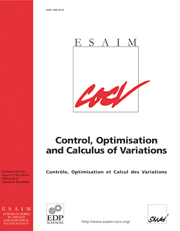Article contents
The H –1-norm of tubular neighbourhoods of curves
Published online by Cambridge University Press: 04 December 2009
Abstract
We study the H –1-norm of the function 1 on tubular neighbourhoods of curves in ${\mathbb R}^{2}$  . We take the limit of small thickness ε, and we prove two different asymptotic results. The first is an asymptotic development for a fixed curve in the limit ε → 0, containing contributions from the length of the curve (at order ε 3), the ends (ε 4), and the curvature (ε 5). The second result is a Γ-convergence result, in which the central curve may vary along the sequence ε → 0. We prove that a rescaled version of the H –1-norm, which focuses on the ε 5 curvature term, Γ-converges to the L 2-norm of curvature. In addition, sequences along which the rescaled norm is bounded are compact in the W 1,2-topology. Our main tools are the maximum principle for elliptic equations and the use of appropriate trial functions in the variational characterisation of the H –1-norm. For the Γ-convergence result we use the theory of systems of curves without transverse crossings to handle potential intersections in the limit.
. We take the limit of small thickness ε, and we prove two different asymptotic results. The first is an asymptotic development for a fixed curve in the limit ε → 0, containing contributions from the length of the curve (at order ε 3), the ends (ε 4), and the curvature (ε 5). The second result is a Γ-convergence result, in which the central curve may vary along the sequence ε → 0. We prove that a rescaled version of the H –1-norm, which focuses on the ε 5 curvature term, Γ-converges to the L 2-norm of curvature. In addition, sequences along which the rescaled norm is bounded are compact in the W 1,2-topology. Our main tools are the maximum principle for elliptic equations and the use of appropriate trial functions in the variational characterisation of the H –1-norm. For the Γ-convergence result we use the theory of systems of curves without transverse crossings to handle potential intersections in the limit.
- Type
- Research Article
- Information
- ESAIM: Control, Optimisation and Calculus of Variations , Volume 17 , Issue 1 , January 2011 , pp. 131 - 154
- Copyright
- © EDP Sciences, SMAI, 2009
References
- 1
- Cited by


